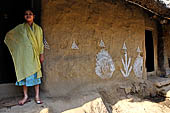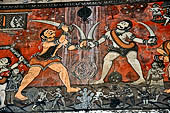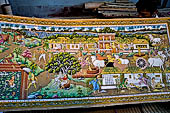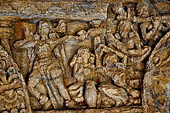Traditional paintings, which ornate Orissan house walls and floor range from geometrical diagrams of earth colours, like others seen elsewhere in India, to the beautiful wall paintings illustrating stories from the Ramayana, like the ones of Ragurajpur. Geometrical diagrams and other symbols are painted on the wall and floor of village houses with white paste prepared from rice, or chalk, on a red background. Designs are usually drawn free hand by women according to a tradition handed down from mother to daughter; patterns are aligned in various sacred directions to form auspicious configurations, believed to protect the huts from malevolent forces. Other subjects are of tribal nature depicting flora or fauna compositions, with scenes from the forest and daily life.
house wall paintings |

|
The art to adorn house walls with bright paintings of mythological scenes has almost died out in Orissa. Many of these paintings can still be seen in the old houses of villages near Puri, especially in the world famous village of Raghurajpur Walls of the homes are painted following the tradition of the caste to which the painter belongs to celebrate family major events like marriages where the nuptial chamber and the verandas outside are painted with particular care. There paintings narrate myths and legends especially from the Ramayana. Deities are painted with particular care. Very peculiar is the representation of a great hero, hunter of wild forest animals. Of tribal origin, the hero got the status of a Hindu God considered to be related to Lord Shiva, or Lord Shiva himself (in the hunter attire).

|
Ragurajpur
|
Traditionally the Patta Chitra Art started as the ritual painting performed in the Lord Jagannatha temple by a cast of painters called Chitrakaras. The Sri Jagannath triad and its great cult have always been the main theme of the pattas. As time passes this tradition moved slowly from the temple precincts to house walls, drawing rooms, lounges of big hotel and guest houses. Similarly the subject of the paintings also got wide variations and nowadays typical subjects ranges from the depiction of different epic episodes to Orissan folklore.
Pattachitra tradition |

|
The vital tradition of Odissi dance was nurtured both in Hindu temples and at the royal court. A bas relief dating to the first century B.C. from the Ranigumpha cave of Udaygiri hills shows a dancer performing with musicians before a royal couple. Innumerable sculptures of dancing maidens adorn Orissan temples culminating in the thirteenth-century Konarak with its natamandapa, or dance hall. Inscriptions from Brahmeswra temple (xi c) and from Anantavasudev temple (xiii c) give evidence of the devadasis system (maidens dancing for God) at those times. Still today Odissi dance is performed to please the God in the Jagannath temple. It is interesting to mention also the, gotipua dancers, boys dressed as girls, dancing outside the temple on festive occasions for public enjoyment.

|
Udaygiri hill
|
|
|
|



